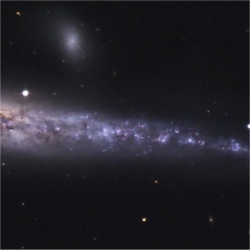
NGC 4631 by Bernd Wallner
People have populated the night sky with animals, mythical heroes, and scientific instruments by connecting the stars into constellations. Similar leaps of imagination have also led observers to give names to nebulas and galaxies based on their resemblance. Thus, M51 is called the Whirlpool Galaxy, M27 is named the Dumbbell Nebula and M57 is known as the Ring. NGC 4631 reminded someone of a Whale, complete with barnacles, and like a harpoon the name stuck to it.
NGC 4631 is an enormous spiral galaxy about the same size as the Milky Way but, by chance, it is turned to us so that we only see its edge. Vast veins of dark dust are visible crisscrossing its length. This matter is a fundamental ingredient to create future solar generations. Not surprisingly, the dark lanes are intermingled with the bright red and blue glows of young star clusters that have just left their nebula nests.
Slightly to the left of center is the golden tale-tale glow of this galaxy’s central region. It’s a side view that’s partially obscured by the front edge of spiral arms we see. Images from the Chandra X-Ray Observatory have shown that NGC 4631 has a halo of hot gases blown from clusters of massive stars in this area. The Milky Way has a similar halo, too.
NGC 4631 belongs to a group of galaxies that are approximately 25 million light years from Earth in the direction of the northern constellation Canes Venatici. The fourteen members of this gathering are located so close together that they interact with each other gravitationally. For example, the small oval shaped companion galaxy seen in this picture may have previously been much larger but lost matter to NGC 4631 as a price for approaching too close and being captured. Also, a slight warp, or curve, is noticeable in this galaxy’s profile. It is thought to be caused by the gravitational tug of other galaxies in this group. Even more noticeable is the effect this galaxy has on one of its neighbors, NGC 4656 (located close-by but outside this picture’s field of view). It is a galaxy so disturbed that it has been named the Hockey Stick.
Bernd Wallner took this beautiful picture of NGC 4631 over three late-April nights this year from his private observatory near Burghausen. Bavaia, Germany. Bernd used his 24-inch Cassegrain reflector telescope and an 11 mega-pixel camera to record 70 separate images that were digitally combined to form this eight and a half hour exposure.
Do you have photos you’d like to share? Post them to the Universe Today astrophotography forum or email them, and we might feature one in Universe Today.
Written by R. Jay GaBany
